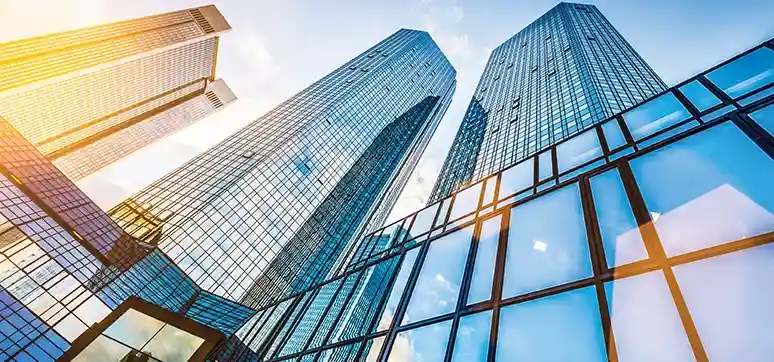Façade is one of the most significant components of a building envelope. It goes about as the essential obstruction against outer climate components that could harm the well being of the structure, for example, downpour, wind, sun, and so on. In contrast to the structural design of the building, the façades are designed in distinct ways on the basis of different architectural styles.

The architects have been deploying the latest façade technologies and materials in their designs and it will keep on changing in the future. Technological advancements in the design trends and new materials will keep on entering the façade industry in the Middle East in the future. Sustainability has always been playing an important role in the selection of façade material and designing process and it will always remain the most important part.
Other than sustainability, increasing global warming will also play an important role in the façades of the future. Innovation will assume an undeniably compelling job in developing structure and façade framework plans. The façades of the future could make the urban infrastructure look more appealing. In this cover story, we have brought the thoughts of industry experts on their expectations from the façade of the future. They have shared their views on different technological advancements which will rule the façade industry in the Middle East and the changes which will take place in the future urban façades and the impact of the same on urban infrastructure.
Features Of The Future Facade

Ian Weekes, Associate Director, Abu Dhabi/Qatar, Meinhardt Façade Technology, quotes “My answer is not going to be what you are expecting. In my tenure as a façade consultant, I have been unfortunate enough to have experienced many poor-quality design and construction issues which are of serious concern. Owners have called for our assistance where their buildings are failing to perform due to poor design and construction administered by façade contractors.”He adds, the duty of the industry is to provide to the client a quality which gives them the assurance of performance for the buildings intended life. In spite of advancements in technology allowing the development of complex parametric structures that retain and excel in thermal performance, the industry lies infected with elements of a lack of requisite qualification and experience to deliver.

“What I would love to see is for our industry to take stock of where we are, look inside themselves and conduct a proper evaluation of the current level of competency they hold, and then effect a structured plan and action to raise that level to the highest standard”, says Weekes. This includes not only gaining knowledge of the development of new improved products but ensuring through training and experience that the products are used correctly to ensure they perform as intended, he adds. He believes that there is a lack of understanding of the importance of the envelope and the materials, components, and engineering required for it to perform to its intention.
He explains that the envelope is the protective barrier between what is often a harsh and aggressive environment and our fragile existence. Like our world, our bodies, our possessions, our items we have gathered in life though the reward of our hard work, are at risk of damage or loss. Some may say this sounds a little dramatic, but those people should pay attention to our world, a world which is suffering at the hands of mankind, and which is screaming for all of us to pay attention.
Mathieu Meur, Director, DP Façade, believes that the façades of the future will have increasingly high solar performance, cutting down on heat gains or losses, while allowing just the right amount of natural daylight to pass through. Façades are also bound to increasingly become connected, as well as to be used to generate electricity. Binoy Kumar Das, Group Managing Director, Façade Concept Design Group, suggests that in future any building envelope to be designed should consider energy efficiency which can bring façade envelope thermal control, so the overall thermal comfort of the building can be optimised.
He adds, any high rise towers/horizontal façade/ double skin/complex geometry, wind studies are most important to carry on before designing the façade. Wind studies like wind simulation, wind load calculation, CFD analysis or even wind tunnel prototype will help to understand and deal with the critical areas on the buildings, also can optimise the design to save cost. Sometimes wind studies help to understand the human comfort at the pedestrian level for users and can help to select right façade systems and materials.
Advancements In The Facade Technology And Materials
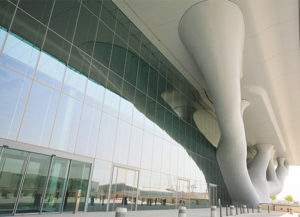
Weekes says that the façade industry has long strived to provide maximum vision with minimum obstruction through the development of ever improving solar controlling coatings. These coatings, as they are developed and enhanced, are becoming more viable as their costs are reducing and their ability to provide a fast return on investment through the associated building energy requirement being reduced. This, combined with the development and improvement of the photovoltaic market, allows the application of energy created from the sun to become more feasible and affordable, with an improvement in efficiency from early developed materials up to current products which are breaking the barrier of 20% efficiency and are targeting numbers in excess of 37% as new products complete their development.
The energy creation side of the market continues to undergo research and development where glass manufacturers are striving to provide products that not only are used on solid colours but also on near-transparent, such that cells can be integrated within all aspects of the envelope without affecting the aesthetic requirements, adds Weekes. Meur says, one of the major advances that he has been following closely over the past few years is adaptive façades. “I started looking into the electrochromic and photochromic glass around 20 years ago when these technologies started emerging. They were not sufficiently mature to be considered on our projects at the time. The situation has changed since then, with several suppliers proposing materials that have now come of age”, adds Meur.

Das notes, in our previous experience, that façade materials selection is most important. Any façade materials to be selected by the architect should relate to climatic control/thermal efficiency/weather protection, etc. In earlier days, while designing the façade, it was mostly enclosed with plasters/ cement board/tiles where the window-wall ratio (the opening ratio is not enough for the building to get better daylight.
There was much contemporary design like the classic design, but over the past few years, many leading architects who have introduced modern façade with maximum visibility around the building which can make the building more aesthetically appealing as part of modern development, so the city getting uplifted to the new era. These kinds of façades where façade engineers/ consultants are much involved at the beginning with the architect team while designing at concept level to bring the right materials on the building envelope. If the envelope of the façade is completely glass then we should run through building physics like daylight, shadow and thermal comfort studies for better performance of the building and also these studies will help to optimise the overall design as cost effective and optimised operation cost of building in long run. This will help to make the environment responsible for the façade.
Key Characters Of A High-Performance Facade

According to Weekes, the key characteristics of a high façade are:
• The ability of the façade to provide thermal performance suitable to the changing climatic conditions
• Structural integrity under wind and seismic loads
• Fire resistance, something which is more critical when we start to introduce new materials and techniques into our industry
• Providing natural light whilst controlling thermal load and glare which is key to the building occupants
• Providing the ability to reduce the energy requirement of the building, thus reducing the environmental impact.
Meur notes, high-performance façades should be perfectly suited to the building that they are applied to, and the interior and exterior environments. It is extremely sad to see buildings constructed with poor-performing façades, wasting precious resources. Instead, with proper experience, the right choices can be made, without necessarily paying more to achieve much-improved performance.
Characters of High-Performance Façade

• Human comfort
• Allow maximum daylight to come in and control solar heat gain so that operation and maintenance costs can be optimised
• Environmentally responsible
• Less external reflection from glass façade
• Less internal reflection from inside
• Usage of green walling over façade
• Selection of insulated glass with Low-e double/triple layer coating to control solar heat gain as per the geometric location.
• Introducing blinds inside the double glass
• Fire smoke barrier in the building for a minimum of 2 hours fire rating. Also, recommend using fire-rated materials
• Atomised ventilation windows connected to the building system which can operate during fire and smoke for human safety and comfort
• Use of laminated glass on the railing and accessible areas for safety
Binoy Kumar Das, Group Managing Director, Façade Concept Design Group
Adaptive Facades – Benefits And Limitations
Weekes says, adaptive façades are not a new idea. Before the invention of air-conditioning, many buildings would have included external shutters which would have been used by the owner to provide, when required, an ability to shade the interior whilst maintaining airflow, thus creating a natural movement of cooled air. But of course, with advances in technology, the industry was able to develop energy-absorbing measures which whilst providing wonderfully controlled internal environments, do so at the expense of the earth’s resources. Hence the need for the industry is to recognise this imbalance and to find new methods.
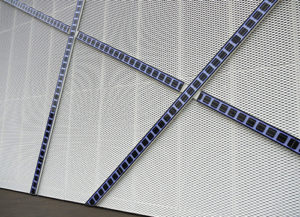
Weekes explains that the modern adaptive façades are being developed to give the opportunity for the envelope to react to its environment through the integration of technology and materials that continue to allow the envelope to regulate internal comfort by using integrated measures that reduce the impact of the building on the environment. A well-known example in Abu Dhabi is the Al Bahar Towers, developed by Aedas Architects with a responsive façade to enhance the insulation of the interior from the energy generated by the sun during its daily path, by the individually controlled automated shading elements.
This is just one of many methods being developed and introduced. Other measures buildings have adopted include those with open and closed cavity façades (CCFs), and those with energy harvesting elements such as photovoltaic panels. The industry is responding. The thermal performance and energy management of buildings are being assessed and ever-improving targets are being applied. With this, we can expect to see more research and development to try and reach a true zero carbon footprint. We see this now as a common practice in European countries. Meur opines that adaptive façades are building envelopes that present varying performance and appearance. The changes can be either automatic, based on environmental considerations, or manually driven using switches or connected apps.
Façade behaves according to climatic conditions are called intelligent façade, which means any building façade design should follow certain studies as per the climatic condition. Adaptation means that façades should adapt to current weather conditions; that is the design of the façade should be as per climatic condition means to understand the temperature difference inside and outside of the building, etc., says Das.
Energy Harvesting Facades
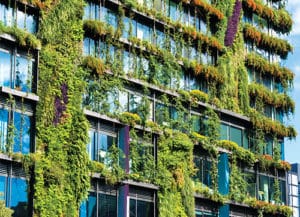
According to Weekes, photovoltaics are the easiest to identify. From what until recently was little more than a solar panel fixed to the roof is now becoming an integrated part of the building envelope. Meur points out that several methods have been investigated to harness energy from building envelopes. One of the most established approaches is BIPV (building-integrated photovoltaics), which converts light or infrared from the sun into electricity. Other methods exist as well to achieve a similar result, in particular, wind turbines built into the façades. New techniques are constantly being investigated, including some that may seem farfetched at first, such as water-filled sunshades containing methane-producing algae, and piezoelectric receptors built into the façade and that convert impacts from raindrops into electricity.
“As a façade consultant, we proposed a dynamic façade design for buildings that aims to increase user comfort, also optimising energy savings”, says Das. The use of solar panels on the façade can produce a huge amount of energy by placing them at the appropriate location. Sun path analysis plays an important role in understanding the angle of the inclination of sun, adds Das.
Tools For Creating Future Facades

The key tool is the ability to not only recognise the opportunities to create carbon-neutral buildings but to ensure that they are properly designed, engineered and installed to work as they are intended, says Weekes. There is no benefit if the envelope fails to perform. This comes from proper research, development, testing, education, and training throughout the whole process. Buildings should be designed with the approach from the natural sunlight paths, to maximise natural light, maximise the usage of photovoltaics and maximise the adaption of either passive or active façades. Meur believes that the main tool required is imagination. If one stays confined to existing materials and solutions, nothing innovative will be created.
Imagination paired with collaboration between various industries and the research, incredible things can happen. Innovative solutions can often be found when one looks beyond the boundaries of one’s realm of expertise and imagines how to apply techniques and materials from other sectors to one’s industry. Das opines that there are many tools for façade designing and comfort studies such as ecotect, e-quest CFD analysis, etc. for comfort studies where Revit and further BIM up to LOD 350 which can get into detail engineering.” I think façade design should require to convert into digitalisation to get better accuracy and time-saving including cost-saving”, adds Das.
Future Opportunities For Smart Facades, Adaptive Facades, And Integrated Facades
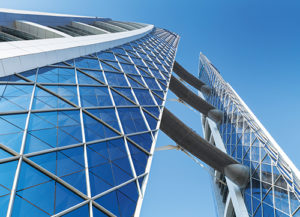
Weekes believes that the opportunities are without limits. All that is needed is the drive and determination of the industry to do what is within its power to save the planet. Meur says that in the coming years, we are bound to see the widespread use of smart, adaptive and integrated façades on buildings. These will likely to be limited to high-end commercial buildings at first, then spread to other categories of buildings. Eventually, there will simply be no room for poor performing building envelopes.
Nowadays smart façade, adaptive façade, and integrated façade are a better future that we all should consider. A façade can be considered as smart when it adapts to environmental conditions and transforms itself simultaneously, says Das. This happens through its components (passive or active), which adjust to adapt to different conditions. When it comes to façades, the main focus is on the equation of maximising natural sunlight, protected from solar radiation, while controlling ventilation and heat input/output. These exchanges can occur through the glazing, which can be considered a smart skin.

Conclusion
The material development and reconciliation for the façade led the route to new façade development. Sustainability and user comfort will always remain the important areas in the world of façades. Energy-efficient façades and smart façades will gain momentum and will become the most important factor to be considered in future façades. These all are our assumptions but it will be interesting to see the changes the façades will have in the future.
